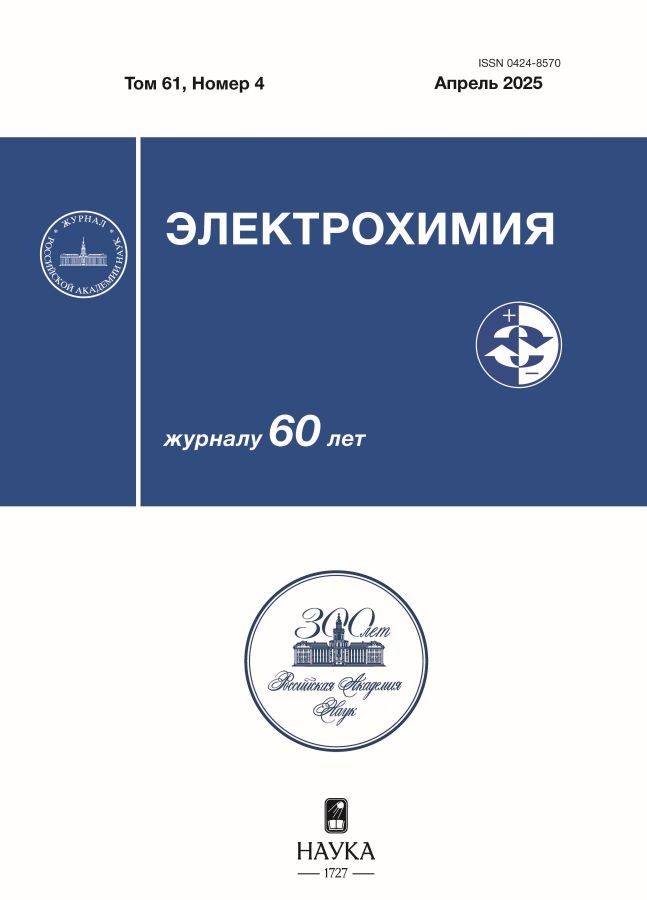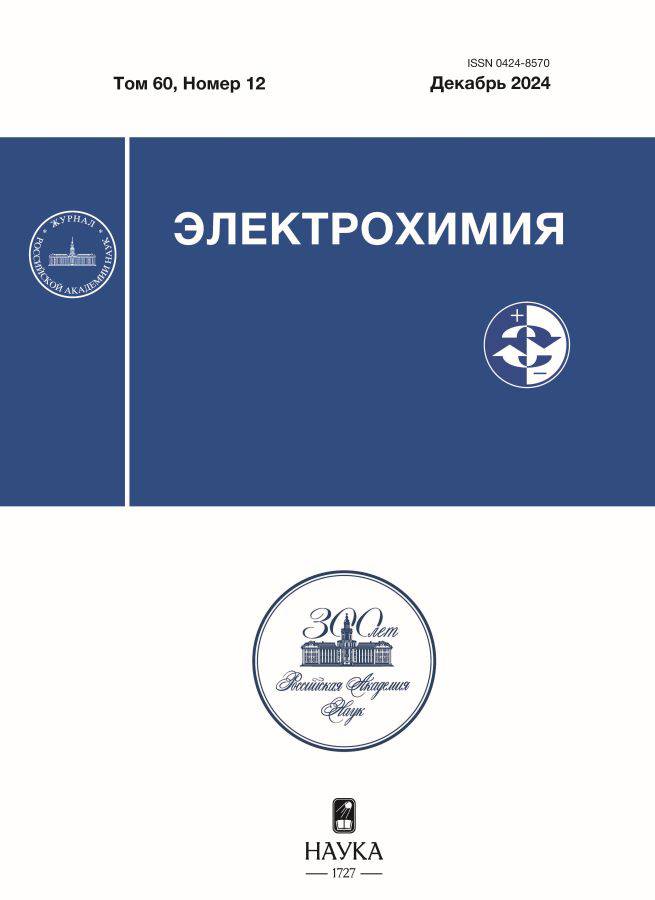Investigation of the properties of soft carbons and graphite by electrochemical impedance spectroscopy. Analysis of the distribution function of relaxation times
- Authors: Kolosnitsyn D.V.1, Kuzmina E.V.1, Egorova N.V.1, Kolosnitsyn V.S.1
-
Affiliations:
- Ufa Federal Research Centre of the Russian Academy of Sciences
- Issue: Vol 60, No 12 (2024): Special issue “Electrochemistry-2023”, part 3
- Pages: 826–840
- Section: Articles by participants of the All-Russian Conference “Electrochemistry-2023” (Moscow, October 23–26, 2023)
- URL: https://permmedjournal.ru/0424-8570/article/view/677976
- DOI: https://doi.org/10.31857/S0424857024120035
- EDN: https://elibrary.ru/NNFXGL
- ID: 677976
Cite item
Abstract
In this work, using the Distribution of Relaxation Times (DRT) function, we analyzed the changes in the electrochemical impedance spectra of lithium-carbon cells during cathodic polarization of a carbon electrode. Soft carbon and graphite were studied as carbon materials. It is shown that the analysis of electrochemical impedance spectra of lithium-carbon cells using the distribution function of relaxation times allows us to establish the number of electrochemical elements and calculate their parameters. Application of DRT functions for modeling of electrochemical impedance showed that there are 8 electrochemical elements in lithium-carbon cells and allowed to quantify their parameters. The obtained results are in good agreement with theoretical ideas about the structure of carbon materials and electrochemical processes occurring during their polarization. The analysis of electrochemical impedance spectra of lithium-carbon cells using the relaxation time distribution function is a more objective method compared to the method of equivalent electrical circuits.
Keywords
Full Text
About the authors
D. V. Kolosnitsyn
Ufa Federal Research Centre of the Russian Academy of Sciences
Author for correspondence.
Email: dkolosnitsyn@gmail.com
Ufa Institute of Chemistry
Russian Federation, UfaE. V. Kuzmina
Ufa Federal Research Centre of the Russian Academy of Sciences
Email: dkolosnitsyn@gmail.com
Ufa Institute of Chemistry
Russian Federation, UfaN. V. Egorova
Ufa Federal Research Centre of the Russian Academy of Sciences
Email: dkolosnitsyn@gmail.com
Ufa
Russian Federation, Ufa Institute of ChemistryV. S. Kolosnitsyn
Ufa Federal Research Centre of the Russian Academy of Sciences
Email: dkolosnitsyn@gmail.com
Ufa Institute of Chemistry
Russian Federation, UfaReferences
- Wang, Y., Ma, Z., and Zhang, X., Mechanism and application in lithium ion batteries of ferrocene catalyzed coal tar pitch to prepare fibrous carbon material with soft and hard carbon hybrid structure, Fuel, 2024, vol. 366, p. 131325. https://doi.org/10.1016/j.fuel.2024.131325
- Babu, B., Carbon–based Materials for Li-ion Battery, Batteries & Supercaps, 2024, vol. 7. https://doi.org/10.1002/batt.202300537
- Mochida, I., Ku, C., Yoon, S., and Korai, Y., Anodic performance and mechanism of mesophase-pitch-derived carbons in lithium ion batteries, J. Power Sources, 1998, vol. 75, Issue 2, p. 214. https://doi.org/10.1016/S0378-7753(98)00101-3
- Чудова, Н. В., Шакирова, Н. В., Кузьмина, Е. В., Колосницын В.С. Влияние диапазона потенциалов заряда и разряда на электрохимическую емкость нефтяного кокса и графита. Башкир. хим. журн. 2021. № 28. С. 85. [Chudova, N.V., Shakirova, N.V., Kuzmina, E.V., and Kolosnitsyn, V.S., Vliyanie diapazona potencialov zaryada i razryada na elektrohimicheskuyu emkost' neftyanogo koksa i grafita, Bashkirskij himicheskij zhurnal (in Russian), 2021, no. 28, p. 85.]
- Schroeder, M., Menne, S., Ségalini, J., Saurel, D., Casas-Cabanas, M., Passerini, S., Winter, M., and Balducci, A., Considerations about the influence of the structural and electrochemical properties of carbonaceous materials on the behavior of lithium-ion capacitors, J. Power Sources, 2014, vol. 266, p. 250. https://doi.org/10.1016/j.jpowsour.2014.05.024
- Kuzmina, E.V., Chudova, N.V., and Kolosnitsyn, V.S., Effect of Current Density on Specific Characteristics of Negative Electrodes for Lithium-Ion Batteries Based on Heat-Treated Petroleum Coke, Russ. J. Electrochem., 2023, vol. 59, p.153.
- Стойнов, З.Б., Графов, Б.М., Савова-Стойнова Б., Елкин, В.В. Электрохимический импеданс. М.: Наука, 1991. 336 с. [Stojnov, Z.B., Grafov, B.M., Savova-Stojnova, B., and Elkin, V.V. Elektrohimicheskij impedans, Moscow: Nauka, 1991. 336p.]
- Импедансная спектроскопия: теория и применение. Учебное пособие. Екатеринбург. Изд-во Урал. ун-та. 2017. [Impedansnaya spektroskopiya: teoriya i primenenie(in Russian). Uchebnoe posobie. Ekaterinburg. Izdatel'stvo Ural'skogo universiteta. 2017.]
- Иванищев, А.В., Чуриков, А.В., Иванищева, И.А. Импедансная спектроскопия литий-углеродных электродов. Электрохимия. 2009. Т. 44. С. 553. [Ivanishchev, A. V., Churikov, A. V., and Ivanishcheva, I. A., Impedance spectroscopy of lithium-carbon electrodes, Russ. J. Electrochem., 2008, vol. 44, p. 510.] https://doi.org/10.1134/S1023193508050030
- Секушин, Н.А. Двухчастотный критерий присутствия индуктивной составляющей в импедансе электрохимической ячейки. Электрохимия. 2010. Т. 46. С. 362. [Sekushin, N. A., Two-frequency criterion of the presence of inductive component in the electrochemical cell impedance, Russ. J. Electrochem, 2010, vol. 46, p. 345.] https://doi.org/10.1134/S1023193510030134
- Ерофеев, А.А. Теория автоматического управления. СПб.: Политехника, 2002. с. 302. [Erofeev, A.A. Teoriya avtomaticheskogo upravleniya (in Russian). St.P.: Politekhnika, 2002. 302 p.]
- Секушин, Н.А. Универсальная эквивалентная схема электрохимической ячейки. Электрохимия. 2009. Т. 45. С. 372. [Sekushin, N.A., Universal equivalent circuit of electrochemical cell, Russ. J. Electrochem., 2009, vol. 45, p. 350.] https://doi.org/10.1134/S1023193509030173
- Kerner, Zsolt & Pajkossy, Tamás, Measurement of adsorption rates of anions on Au(111) electrodes by impedance spectroscopy, Electrochim. Acta, 2002, vol. 47, p. 2055. https://doi.org/10.1016/S0013-4686(02)00073-7
- Lasia, Andrzej. Electrochemical Impedance Spectroscopy and Its Applications. Springer, 2014.
- Schelder, W., Theory of the Frequency Dispersion of Electrode Polarization. Topology of Networks with Fractional Power Frequency Dependence, J. Phys. Chem., 1975, vol. 79, p. 127.
- Kerner, Z. and Pajkossy, T., Impedance of rough capacitive electrodes: The role of surface disorder, J. Electroanal. Chem., 1998, vol. 448, p. 139.
- Kerner, Z. and Pajkossy, T., On the origin of capacitance dispersion of rough electrodes, Electrochim. Acta, 2000, vol. 46, p. 207.
- Гаврилюк, А.Л., Осинкин, Д.А., Бронин, Д.И. О применении метода регуляризации Тихонова для вычисления функции распределения времен релаксации в импедансной спектроскопии. Электрохимия. 2017. Т. 53. С. 651. [Gavrilyuk, A.L., Osinkin, D.A., and Bronin, D.I., The use of Tikhonov regularization method for calculating the distribution function of relaxation times in impedance spectroscopy, Russ. J. Electrochem., 2017, vol. 53, p. 575.] https://doi.org/10.1134/S1023193517060040
- Qu, H., Zhang, X., Ji, W., Zheng, D., Zhang, X., and Ji, W., Impedance investigation of the high temperature performance of the solid-electrolyte-interface of a wide temperature electrolyte, J. Colloid and Interface Sci., 2022, vol. 608, p. 3079.
- Macutkevic, J., Banys, J., and Matulis, A., Determination of the Distribution of the Relaxation Times from Dielectric Spectra, Nonlinear Analysis. Modelling and Control, 2004, vol. 9, p. 75. https://doi.org/10.15388/NA.2004.9.1.15172
- Schönleber, Michael & Ivers-Tiffée, E., Approximability of impedance spectra by RC elements and implications for impedance analysis, Electrochem. Commun., 2015. https://doi.org/10.1016/j.elecom.2015.05.018
- Wan, T.H., Saccoccio, M., Chen, C., and Ciucci, F., Influence of the Discretization Methods on the Distribution of Relaxation Times Deconvolution: Implementing Radial Basis Functions with DRTtools, Electrochim. Acta, 2015, vol. 184, p. 483.
- Свид. 2022665869 РФ. Свидетельство об официальной регистрации программы для ЭВМ. “ElChemLab, DRT Analyzer” / Д.В. Колосницын; правообладатель УФИЦ РАН (RU). Опубл. 23.08.2022, Реестр программ для ЭВМ. 1 с. [2022665869 RF. “ElChemLab, DRT Analyzer” / D.V. Kolosnitsyn; UFRC RAS (RU). – published. 23.08.2022]
- Прилежаева, И.Н., Соловьев, Н.П., Храмушин, Н.И. Способ преобразования спектров импеданса для определения механизма электрохимической реакции. Электрохимия. 2004. Т. 40. С. 1425. [Prilezhaeva, I.N., Solov'ev, N.P., and Khramushin, N.I., A procedure for transforming impedance spectra for the determination of mechanism of electrochemical reactions, Russ. J. Electrochem., 2004, vol. 40, p. 1223.] https://doi.org/10.1023/B:RUEL.0000048659.28543.0c
- Zhang, S. and Shi, P., Electrochemical impedance study of lithium intercalation into MCMB electrode in a gel electrolyte, Electrochim. Acta, 2004, vol. 49, p. 1475. https://doi.org/10.1016/j.electacta.2003.10.033
- Zaban, A., Zinigrad, E., and Aurbach, D., Impedance Spectroscopy of Li Electrodes. 4. A General Simple Model of the Li-Solution Interphase in Polar Aprotic Systems, J. Phys. Chem., 1996, vol. 100, p. 3089.
- Wang, C., Appleby, A.J., and Little, F., Low-Temperature Characterization of Lithium-Ion Carbon Anodes via Microperturbation Measurement, J. Electrochem. Soc., 2002, vol. 149, p. A754. https://doi.org/10.1149/1.1474427
- Holzapfel, M., Martinent, A., Alloin, F., Le Gorrec, B., Yazami, R., and Montella, C., First lithiation and charge/discharge cycles of graphite materials, investigated by electrochemical impedance spectroscopy, J. Electroanal. Chem., 2003, vol. 546. p. 41. https://doi.org/10.1016/S0022-0728(03)00144-X
- Plank, Christian & Rüther, Tom & Jahn, Leonard & Schamel, Maximilian & Schmidt, Jan & Ciucci, Francesco & Danzer, Michael, A review on the distribution of relaxation times analysis: A powerful tool for process identification of electrochemical systems. J. Power Sources, 2023, vol. 594. https://doi.org/10.1016/j.jpowsour.2023.233845
- Lu, Yang & Zhao, Chen-zi & Huang, Jia-Qi & Zhang, Qiang, The timescale identification decoupling complicated kinetic processes in lithium batteries, Joule, 2022, vol. 6, p. 1172. https://doi.org/10.1016/j.joule.2022.05.005
Supplementary files

















